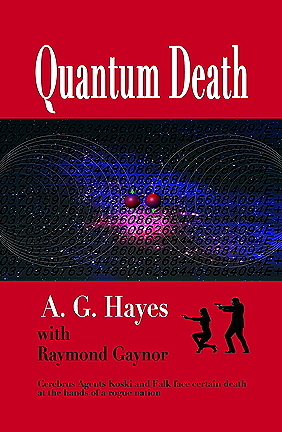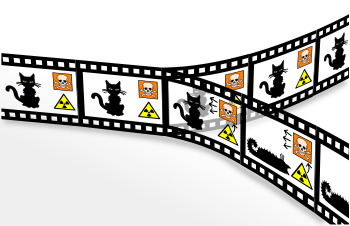Raymond Gaynor's Blog, page 70
September 23, 2016
IT'S A BIRD...IT'S A PLANE...IT'S A WAVE GOODBYE!
In QUANTUM DEATH (Savant 2016), A. G. Hayes and I introduce the Quantum Death Machine, a theoretical weapon not so much of mass destruction (WMD) as of mass infrastructure interference (WMII). In this new scenario, the objective isn't to destroy an enemy so much as paralyze it, allowing the aggressor to acquire all its resources intact. Our Quantum Death Machine is based on some of the emerging characteristics of theoretical #quantum physics and it's overarching #M-Superstring Theory. in the evolving field of applied physics, it's about using and applying these characteristics. In applied physics, perhaps the most fundament question remains when a wave becomes a particle and vice versa. After all, a wave is insubstantial; a quantum wave typically can't be seen or held and examined between a thumb and forefinger. Tossing a wave somewhere doesn't make much sense. A particle on the other hand is more substantial; even a quantum particle, with assistance, can be at least indirectly observed, captured and examined, and, like a bullet it can be sent flying in one direction in a projection of power. That's a lot of what the European Organization for Nuclear Research, called #CERN, is investigating with the Large Haldron Collider these days.

<Standing Waves from Wikipedia Commons>
Quantum physics holds that a wave and its particle are indistinguishable at a certain point in situational space/time. My favorite example of this is to start with a standing wave. Hold a string at each end in a thumb and finger and move one end up and down and it looks like a wave. A standing wave has two key measurements: its frequency of vibration and its length (technically the length from non-vibrating node to non-vibrating node). In a sense, the former defines the wave's inherent energy, while the latter defines a wave's effective size. At the moment when the wave and particle are one, the same is true of the corresponding particle: In particle terms, the former defines the particle's inherent energy, while the latter defines its effective size.
So, wave? Particle? Or both at the same time? It's left to the observer to decide based on the immediate situation. M-Superstring Theory, however, holds that a string vibrating as a standing wave of incredibly small diameter is the fundamental basis for everything "real" that we interact with in the cosmic, quantum and our "normal-sized" world. At least, that's my current take on it.
In QUANTUM DEATH, it is these properties of wave/matter that are at the heart of the Quantum Death Machine (QDM) that threatens the existence of North America and the world. It's up to Cerebrus Agents Susan Koski and Joseph Falk to save everyone, if possible, with a little help from Cerebrus brilliant female scientist Kate Keenan on special assignment. In writer's terms the QDM is the MacGuffin, but in QUANTUM DEATH it's an entirely plausible one. That's what makes QUANTUM DEATH a real #thriller.
September 20, 2016
THE GHOST IN THE BOX
In QUANTUM DEATH (Savant 2016), Cerebrus Agents Koski and Falk are challenged with facing and defeating a kvantovaya mashina smerti or Quantum Death Machine (QDM) being used to bring the United States and all of the Americas to their knees. But is the alleged QDM a simple writer's MacGuffin or is it more substantial? Could it really happen?
I believe the answer is "yes," which, I hope, makes this techno-thriller even more intensely gripping.

A deeper explanation is that the QDM is based on a new "theory of everything" called M-Superstring Theory in which single-dimension "strings" replace particles while preserving their quantum wave characteristics. These strings exist not in three (length, width, depth) or even four (time) dimensions, but require exactly 11 dimensions to characterize. We humans are not able to sense the seven extra dimensions, but mathematically, M-Superstring Theory is said to unite the cosmic with the quantum in a Unified Field Theory.
https://www.youtube.com/user/MichioKakuVideos
M-Superstring Theory, when applied, posits the existence of not just our universe, but an infinite number of universes (called "branes"), theoretically allowing for not only instantaneous teleportation within one universe but also from one universe to another. It is upon this characteristic of M-Superstring theory (think of "wormholes" or rents is time/space) and quantum simultaneity, a unique property of quantum particle/waves allowing one object to momentarily exist in two or more places at the same time (think Star Trek transporter), that the kvantovaya mashina smerti or Quantum Death Machine (QDM) was built. And if you're shaking your head in disbelief, be assured that both properties have actually already been demonstrated in our sized physical world:
http://www.anu.edu.au/news/all-news/experiment-confirms-quantum-theory-weirdness
Of course, I added a little "Raymondism" to all of the above -- What's a cake without icing? -- keep all of this in mind when you re-read QUANTUM DEATH (Savant 2016) by A. G. Hayes with Raymond Gaynor.
September 19, 2016
QUANTUM SUICIDE AND THE IMMORTAL CAT

<image from Wikipedia Commons>
There is another interpretation, however, created by Max Moravic in 1956 called the "Many-worlds interpretation" of "Quantum Suicide." Incorporating M-Superstring theory, which posits the existence of an infinite number of universes (the multiverse), the cat, as long as one doesn't open the box, is indeed simultaneously alive and dead but the "alive" and "dead" cats exist in different universes of the multiverse, each live/die "event" represented by a branching of the cat's universe, the new and old universes not being able to interact with one another. In effect the cat remains alive in some universe, and, like the "soul" is immortal. I find this "Multiverse" or "Many-worlds interpretation" hopeful at the least, joyful at the best. Death, in essence, simply involves the normal decay and loss of one's bodily self in one universe eventually resulting in the transfer of the "soul" to another universe where another physical body exists. Interestingly, in this interpretation, each person's new body and "afterlife" may be considerably different, leading to an infinite number of heavens, hells and in-betweens, and a whole new lifeline.
In QUANTUM DEATH, brilliant woman scientist and computer expert Kate Keenan, comes up with a further variant of the "Many-worlds interpretation" of the physics behind the Quantum Death Machine, one which transcends the Atomic Age and moves humanity in this universe into the Quantum Age.



